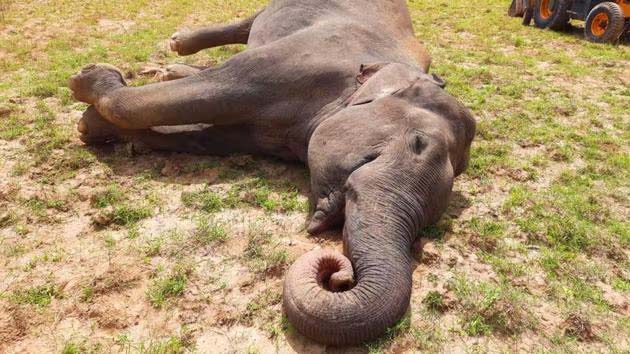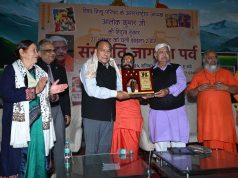By Arun Pratap Singh
Garhwal Post Bureau
Dehradun, 2 Oct: The Haridwar Forest Division is in the news again for wrong reasons. This division is now witnessing a distressing rise in elephant mortalities. In a short span of just six days, the carcass of a third elephant has been recovered under circumstances that authorities have described as suspicious. Experts insist that the spate of fatalities should be seen against the backdrop of ongoing investigations into illegal wildlife crime in the Division, including a venom trade scandal, intensifying scrutiny of forest practices and protection measures.
Traditionally, Haridwar Division is known for being a very crucial transit zone for elephants, especially given its proximity to Rajaji National Park, which lies partly in the Haridwar district. However, the recent clustering of deaths suggests that the area may now become an epicentre not only of movement but of mortality. Forest officials from Haridwar have confirmed the recovery of three elephant bodies over the past week, each death triggering wider concern and speculation over causes and accountability.
It may be recalled that the first death of an elephant in the current series was reported on 26 September in the Khanpur Range, where a male elephant aged between 30 and 35 years was found dead in a guava orchard on private land. The forest department has not yet confirmed the cause of death though the local residents have speculated electrocution as the reason behind the death. A detailed post-mortem report is still awaited. The second incident occurred on 29 September, also within Khanpur Range near Buggawala village, on private property adjacent to forest land. The deceased was identified by locals as the “one-tusked” elephant frequently seen in residential zones. The department has ruled the cause as electrocution, and preparations are underway to file a case against the landowner and initiate legal proceedings.
Then, on 1 October, the body of a third elephant was discovered in the Shyampur Range. Initial on-site assessments suggested the animal, approximately 30 years old, succumbed to extreme weakness and heart failure. Yet photographs showing solar fencing in close proximity to the carcass have raised questions about whether an induced element might have contributed to the demise. With three deaths in quick succession, the pattern cannot be dismissed as coincidence.
These incidents come at a time when the Haridwar Division is already under a cloud of controversy. A prominent case involves the discovery of an illegal venom trade network, a wildlife crime of rare severity in this region. In fact, former union minister and noted animal rights activist Maneka Gandhi has also levelled serious allegations in the venom case. So far, the forest officials have been unable to apprehend the operators of the racket, and questions are mounting about institutional oversight and interdepartmental coordination. In the midst of this, the repeated elephant deaths cast additional doubts over the operational effectiveness of forest vigilance in the area.
Speaking to Garhwal Post, Forest Minister Subodh Uniyal today confirmed that he has ordered the Chief Wildlife Warden to send a team to Haridwar to urgently investigate the patterns of mortality. Senior officials from the Uttarakhand Forest Department have already arrived to inspect the sites of the deaths and oversee field-level forensics and support. Forest Conservator (Shivalik) Rajiv Dhiman stated that the officials are visiting the locations where the elephants died to ascertain the causes of death in coordination with veterinary teams. Post-mortem reports and laboratory analysis are awaited.
It may also be reminded here that a male elephant in the Buggawala area died after coming in contact with an electric fence erected illegally by farmers, prompting the forest department to detain two caretakers for questioning and register a case under the Wildlife Protection Act. Officials have also revealed that sampling of water and vegetation has been undertaken to investigate possible poisoning in other cases. In the wake of consecutive deaths, the department claims to have initiated a crackdown on illegal electric fencing in farmlands adjacent to forest areas. The officials claim that several electric fences across dozens of plots have been dismantled, and the landowners have been booked for installing them.
Adding to the concern is the fact that elephants in the Haridwar Forest Division and the adjoining Rajaji National Park have often fallen victim to railway accidents. These deaths usually occur when trains run on this stretch at speeds beyond the permissible limits. Train drivers are mandated to operate at lower speeds through these sensitive stretches in view of the possibility of wildlife being run over, yet such regulations are frequently violated, leading to avoidable tragedies.
At the same time, Haridwar has also reported an intense public fascination with elephant sightings. The locals have reportedly gathered to film passing herds and make short video reels, often crowding near highways and village edges, thereby increasing risk both for themselves and for the elephants. This behaviour has further complicated the already tense scenario by creating additional challenges for crowd management and wildlife protection.
Given the sensitive nature of forest-human interfaces in Haridwar, these clustered elephant deaths need to be viewed in a broader ecological context. The Rajaji corridor is recognised as a critical link for elephant migration, and any disruption, whether by electrocution, poisoning, or neglect, can have a strong negative impact on population movement, behaviour, and local ecological balance. The environmentalists insist that the forest authorities must be forced to demonstrate greater transparency, expedite laboratory results, prosecute wrongdoing, and strengthen preventive measures that can deter future fatalities. Unless these systemic gaps are addressed swiftly, elephants traversing the Haridwar Division may increasingly find peril rather than passage in their age-old migratory routes.








